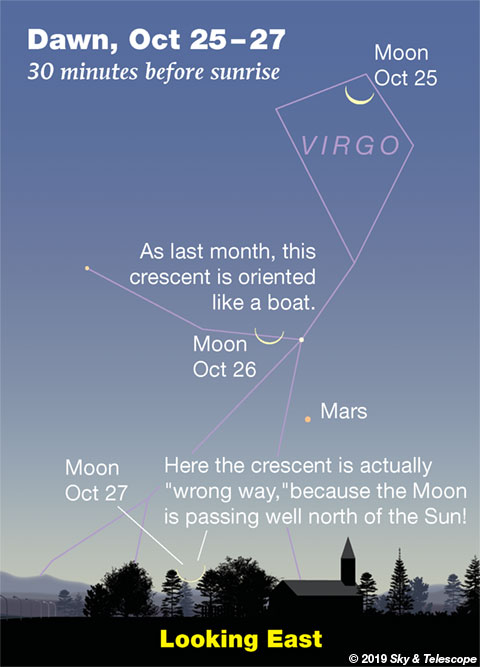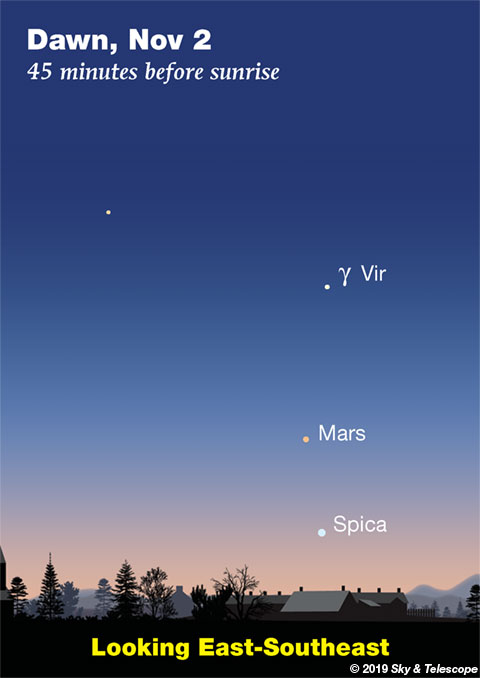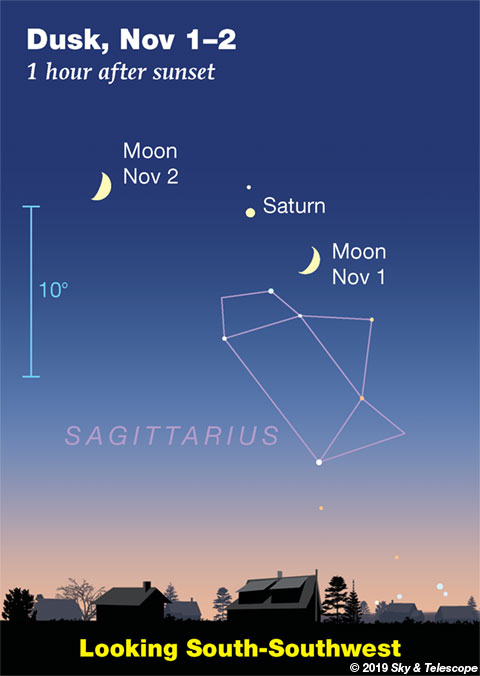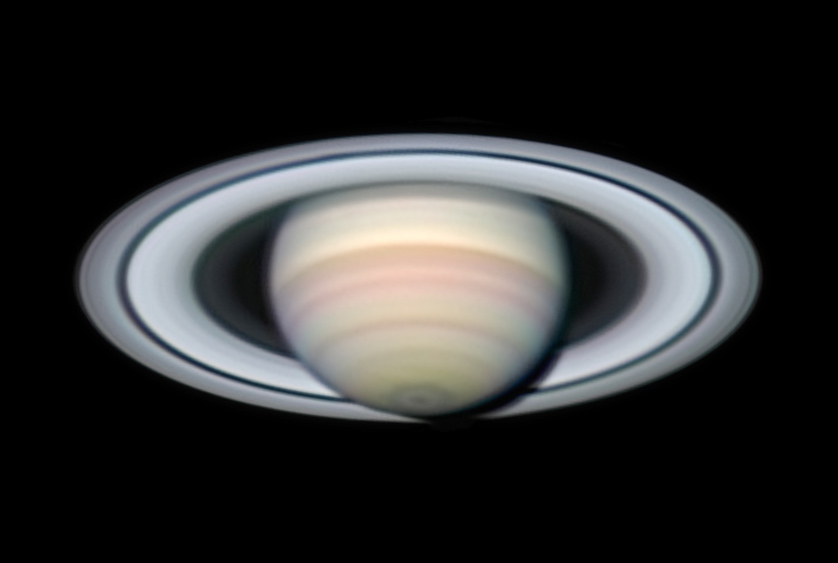

Friday, Oct. 25
• The Ghost of Summer Suns. Halloween is approaching, and this means that Arcturus, the star sparkling low in the west-northwest in evening twilight, has taken on its role as "the Ghost of Summer Suns." For several days centered on October 25th every year, Arcturus occupies a special place above your local landscape. It closely marks the spot where the Sun stood at the same time, by the clock, during hot June and July — in broad daylight, of course!
So, as Halloween approaches every year, you can see Arcturus as the chilly ghost of the departed summer Sun.
Saturday, Oct. 26
• The W of Cassiopeia now stands vertically on end in the evening, high in the northeast.
Look to its right, high in the east, for Andromeda and the corner-balanced Great Square of Pegasus.
Sunday, Oct. 27
• Spot bright Altair high in the southwest soon after dark. Brighter Vega is far to its right.
Two distinctive little constellations lurk above Altair: Delphinus the Dolphin, hardly more than a fist at arm's length to its upper left, and smaller, fainter Sagitta the Arrow, slightly less far to Altair's upper right. Light pollution too bright? Use binoculars!
• New Moon (exact at 11:38 p.m. Eastern Daylight Time).
Monday, Oct. 28
• It's getting to be the time of year when the Big Dipper lies down horizontal low in the north-northwest in the evening. How low? The farther south you are, the lower. Seen from 40° north (New York, Peoria, Denver) even its bottom stars twinkle nearly ten degrees high. But at Miami (26° N) the entire Dipper will skim along out of sight just below the northern horizon.
• Uranus is at opposition.
Tuesday, Oct. 29
• About 20 minutes after sunset, look very low in the southwest for the very thin crescent Moon, two days old. Venus is just a few degrees under it (for North America). Binoculars give the best view.
Wednesday, Oct. 30
• Shortly after sunset, look low in the southwest for the thin crescent Moon. To its upper left is Jupiter. Farther to the Moon's lower right, Venus is about to set.
Look much farther upper left of Jupiter, and there's Saturn.
Thursday, Oct. 31
• Halloween Moon and giants. As dusk descends on North America this evening, you'll find the crescent Moon low in the southwest. That dot glowing 4° or 5° to its lower right is Jupiter.
Yellow Saturn, also a gas giant, glows several times farther to the Moon's upper left.

Friday, Nov. 1
• Now at dusk, the waxing crescent Moon is only 4° or 5° lower right of Saturn. Look much farther lower right for Jupiter.
Saturday, Nov. 2
• Saturn shines to the right of the Moon in early evening. Much higher above them is Altair, a little brighter than Saturn.
• Capella sparkles low in the northeast these evenings. Look for the Pleiades cluster, fingertip-size, about three fists at arm's length to Capella's right. These harbingers of the cold months rise higher as evening grows late.
Upper right of Capella, and upper left of the Pleiades, the stars of Perseus lie astride the Milky Way.
• Standard time resumes at 2 a.m. Sunday morning for most of North America. Clocks fall back an hour. And for astronomers, darkness will henceforth arrive an hour earlier!
________________________
Want to become a better astronomer? Learn your way around the constellations. They're the key to locating everything fainter and deeper to hunt with binoculars or a telescope.
This is an outdoor nature hobby. For an easy-to-use constellation guide covering the whole evening sky, use the big monthly map in the center of each issue of Sky & Telescope, the essential guide to astronomy.

Once you get a telescope, to put it to good use you'll need a detailed, large-scale sky atlas (set of charts). The basic standard is the Pocket Sky Atlas (in either the original or Jumbo Edition), which shows stars to magnitude 7.6.
Next up is the larger and deeper Sky Atlas 2000.0, plotting stars to magnitude 8.5; nearly three times as many. The next up, once you know your way around, are the even larger Interstellarum atlas (stars to magnitude 9.5) and Uranometria 2000.0 (stars to magnitude 9.75). And you'll need to know how to use sky charts with a telescope.
You'll also want a good deep-sky guidebook, such as Sue French's Deep-Sky Wonders collection (which includes its own charts), Sky Atlas 2000.0 Companion by Strong and Sinnott, or the bigger Night Sky Observer's Guide by Kepple and Sanner.
Can a computerized telescope replace charts? Not for beginners, I don't think, and not on mounts and tripods that are less than top-quality mechanically (meaning really heavy and expensive). And as Terence Dickinson and Alan Dyer say in their Backyard Astronomer's Guide, "A full appreciation of the universe cannot come without developing the skills to find things in the sky and understanding how the sky works. This knowledge comes only by spending time under the stars with star maps in hand."
This Week's Planet Roundup
Mercury and Venus are very low in bright twilight after sunset. Start by trying for Venus, magnitude –3.9. It's just above the southwest horizon a mere 20 minutes after sunset. Binoculars will help.
Mercury is much dimmer at about magnitude 0.0. It's 5° left of Venus on the October 25th and 3° below Venus by the 31st (seen from the world's mid-northern latitudes). Good luck trying; bring binoculars at least!
Mars (a mere magnitude +1.8, in Virgo) is a difficult catch just above the east horizon in early dawn. Again, you'll need binoculars. Don't confuse it with much brighter Arcturus, also orange-ish, which is 31° to Mars's left.
Jupiter (magnitude –1.9, in southern Ophiuchus) is the creamy-white dot low in the southwest as twilight fades.

Saturn (magnitude +0.6, in Sagittarius) is the steady yellow "star" in the south-southwest during and after dusk. It's about 23° upper left of Jupiter.
Still below Saturn this week is the handle of the Sagittarius Teapot, highlighted by 2.0-magnitude Sigma Sagittarii (Nunki). Barely above Saturn is the dimmer, smaller bowl of the Sagittarius Teaspoon.
Uranus (magnitude 5.7, in southern Aries) is at opposition on the night of October 27-28. This week it's well up in the east by 9 p.m. daylight saving time and highest in the south around midnight or 1 a.m.
Neptune (magnitude 7.8, in eastern Aquarius) is in high view in the southern sky these evenings. See our finder charts for Uranus and Neptune and Bob King's story on observing Neptune.
All descriptions that relate to your horizon — including the words up, down, right, and left — are written for the world's mid-northern latitudes. Descriptions that also depend on longitude (mainly Moon positions) are for North America.
Eastern Daylight Time (EDT) is Universal Time (UT, UTC, GMT, or Z time) minus 4 hours.
![]() Audio sky tour. Out under the evening sky with your earbuds in place, listen to Kelly Beatty's monthly podcast tour of the heavens above. It's free.
Audio sky tour. Out under the evening sky with your earbuds in place, listen to Kelly Beatty's monthly podcast tour of the heavens above. It's free.
"The dangers of not thinking clearly are much greater now than ever before. It's not that there's something new in our way of thinking, it's that credulous and confused thinking can be much more lethal in ways it was never before."
— Carl Sagan, 1996
 5
5








Comments
misha17
October 25, 2019 at 3:16 pm
A couple of days ago, I was out walking the dog at 6:30am, about 45 minutes before sunrise. I'm pretty sure I saw Arcturus low in the ~Northeast~ sky. We've been having temperatures in the 90s this week here in Southern California, so the star is more that just the "Ghost of Summer Suns"; it was also a precursor of the summer-like weather we were going to have later that same day.
You must be logged in to post a comment.
Rod
October 31, 2019 at 5:51 am
mary beth, Houston we have a problem, they call them the NATS! No stargazing for me last night in Maryland 🙂
You must be logged in to post a comment.
mary beth
October 31, 2019 at 11:47 am
Haha!! Quite a series!! Happy Halloween ⚰️! First clear night in a few. Looking forward to seeing the Ghost of the Summer Suns tonight......
You must be logged in to post a comment.
Rod
October 31, 2019 at 12:55 pm
mary beth, sounds good and glad you enjoyed my NATS note 🙂 I have light rain today and more tonight but Friday through Sunday nights look much better here, clear to mostly clear skies. I plan to setup my telescopes and get back out for some fun. Enjoy your skies tonight in Houston.
You must be logged in to post a comment.
mary beth
November 1, 2019 at 1:35 am
Thanks Rod! Beautiful crescent moon on the coldest Halloween since 1925 in Houston. Very nice night here, and hope you have a good clear weekend!
You must be logged in to post a comment.
You must be logged in to post a comment.